LEP2 Physics
At LEP1, the collision energy was set equal to the mass of the
Z-boson, 91 GeV, so most of the events observed involved the formation of
the Z. You can find lots of
LEP1 event pictures
elsewhere.
In November 1995 the LEP energy was increased to 130-140 GeV;
you can find information about that
"LEP1.5" run here.
Here we show some events recorded at LEP2. In LEP2, the collision
energy was increased to 161 GeV (July 1996), then 172 GeV (October 1996)
and beyond.
The main purpose is to have sufficient energy to create
pairs of W bosons, the charged gauge bosons of the electroweak theory.
These can be produced by the following mechanisms:
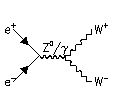
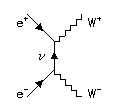 .
.
The W-W-Z and W-W-photon vertices in these diagrams are
precisely predicted by the Standard Model, so observations
of W+W- production can be used to test the theory.
The mass of the W boson is also precisely predicted using
the Standard Model and LEP1 data, so a measurement of the
W mass will be a powerful check of the theory.
Each W boson decays either to lepton and neutrino, or to
quark and antiquark. The signatures of W+W- production are therefore
four jets of hadrons, or two jets of hadrons together with an
energetic isolated lepton and missing energy, or a pair of leptons
with missing energy.
-
Here is the first good W+W- candidate (a four jet event) recorded by OPAL at 161 GeV centre-of-mass energy

 The red and yellow jets form a mass of 78 GeV, and the blue and green
jets form a mass of 77 GeV.
The red and yellow jets form a mass of 78 GeV, and the blue and green
jets form a mass of 77 GeV.
-
Here is a W+W- candidate where one W decays to electron and neutrino,
and the other to quarks:

 The 40 GeV electron is highlighted in red,
and the two jets form a mass of 80 GeV.
This event was recorded in the 161 GeV data.
The 40 GeV electron is highlighted in red,
and the two jets form a mass of 80 GeV.
This event was recorded in the 161 GeV data.
-
Here is a W+W- candidate where one W decays to muon and neutrino,
and the other to quarks:

 The 45+-3 GeV muon is highlighted in red,
and the two jets form a mass of 80 GeV. Ths missing momentum (which indicates
the formation of the neutrino) is shown by the arrow, and is opposite
to the muon.
This event was recorded in the 161 GeV data.
The 45+-3 GeV muon is highlighted in red,
and the two jets form a mass of 80 GeV. Ths missing momentum (which indicates
the formation of the neutrino) is shown by the arrow, and is opposite
to the muon.
This event was recorded in the 161 GeV data.
-
And here is a W+W- candidate where one W decays to tau and neutrino,
and the other to quarks:

 The track arising from the tau decay is highlighted in magenta,
and the two jets form a mass of 77 GeV.
This event was recorded in the 161 GeV data.
The track arising from the tau decay is highlighted in magenta,
and the two jets form a mass of 77 GeV.
This event was recorded in the 161 GeV data.
-
Here is a W+W- candidate where one W decays to electron and neutrino,
and the other to muon and neutrino:

 The 40 GeV muon is highlighted in red, and the 40 GeV electron
is highlighted in yellow.
This event was recorded in the 161 GeV data.
The 40 GeV muon is highlighted in red, and the 40 GeV electron
is highlighted in yellow.
This event was recorded in the 161 GeV data.
Other events in which four fermions are formed involve
neutral currents (the Z and photon), and there also become important at LEP2.
Here is an example of an event in which an electron-positron pair
(highlighted in magenta) recoils against a pair of jets:

 .
The jets are consistent with arising from a Z0 decay, and the
lower mass electron pair is formed from a virtual photon.
This event was recorded in the 161 GeV data.
.
The jets are consistent with arising from a Z0 decay, and the
lower mass electron pair is formed from a virtual photon.
This event was recorded in the 161 GeV data.
Many of the events recorded are similar to those at LEP1,
where a lepton pair or quark-antiquark pair is produced
in the decay of a virtual Z boson or photon, e.g.:
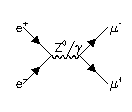 .
.
-
Here is an example of a Z/photon decay to quarks, yielding
two back-to-back jets of hadrons


-
And here is a three jet event at 161 GeV, where one of the quarks
has emitted a gluon:


-
In addition, many of the events show "radiative return";
the scattering is especially favoured if one or more photons are
emitted from the initial e+ or e-, so that the energy is reduced
to the mass of the Z boson, e.g.:
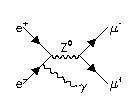 .
.
Here is an example of a radiative return to the Z, where the Z decays to
quarks (actually the first hadronic event recorded by OPAL at LEP2).
The mass of the observed hadronic system is 94 GeV,
consistent with theZ boson mass:

 .
.
-
And here is another with mass 89 GeV recorded a few minutes later:

 .
.
-
Here is a striking event in which two energetic radiated photons
are observed in the electromagnetic calorimeter.

 .
.
Other processes, which were comparatively rare at LEP1,
become more common at LEP2. For example, the production
of a pair of photons:
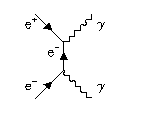
which provides a stringent test of QED, and could give indication
of composite structure of the electron. Here is an example of
such an event at LEP2:

 .
.
Occasionally in such an event, one of the photons may convert into
a quark-antiquark pair, thus materialising as a jet of hadrons.
Here is a spectacular example where an 80 GeV photon recoils against
a hadronic jet of mass about 10 GeV:

 .
(the track marked in red is a muon).
.
(the track marked in red is a muon).
In the above event pictures,
tracks measured in the central tracking system are shown in blue.
Small green boxes show hits in the time-of-flight system. Clusters of
energy in the lead glass electromagnetic calorimeter are shown as
yellow boxes, of size proportional to their energy. Similarly,
clusters of energy in the hadron calorimeter are drawn in magenta,
and energy in the forward luminosity calorimeters in green.
Penetrating charged particle tracks, which are candidates for muons,
are shown as red arrows.
You can also see LEP-2 events observed by the other LEP experiments:
ALEPH,
DELPHI and
L3.
During the campaign to increase the LEP energy, the first
events taken in e+e- collisions significantly
above the Z0 mass were collected in
a short "LEP1.5" run
in October 1995.
The OPAL Webweavers
Last updated 25 May 1998 by R. Van Kooten

 The last OPAL physics event of the year 2000 - perhaps of all time!
(Postscript version, for printing)
The last OPAL physics event of the year 2000 - perhaps of all time!
(Postscript version, for printing)

 .
.

 .
. .
.